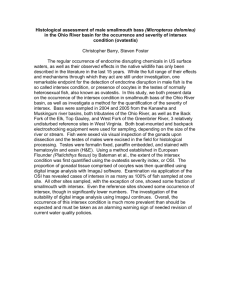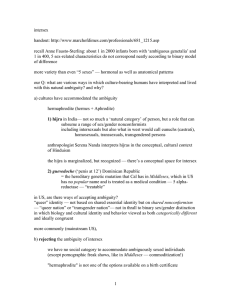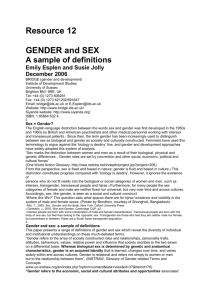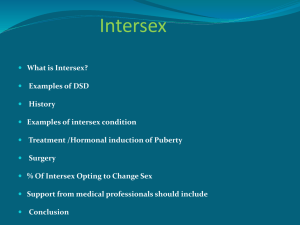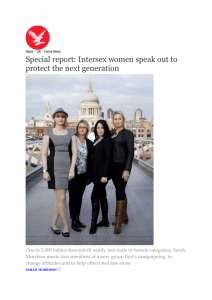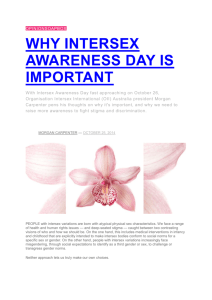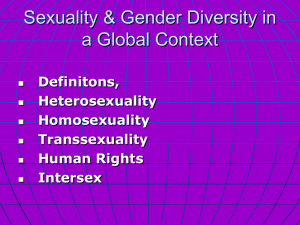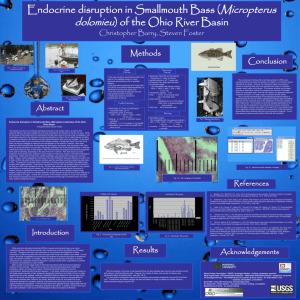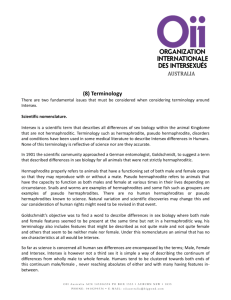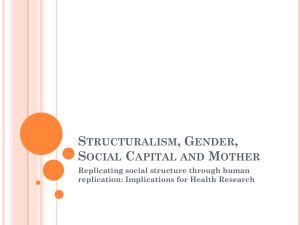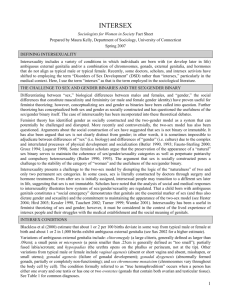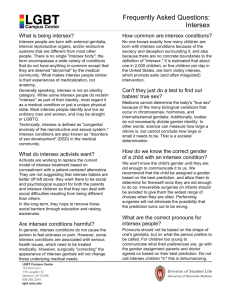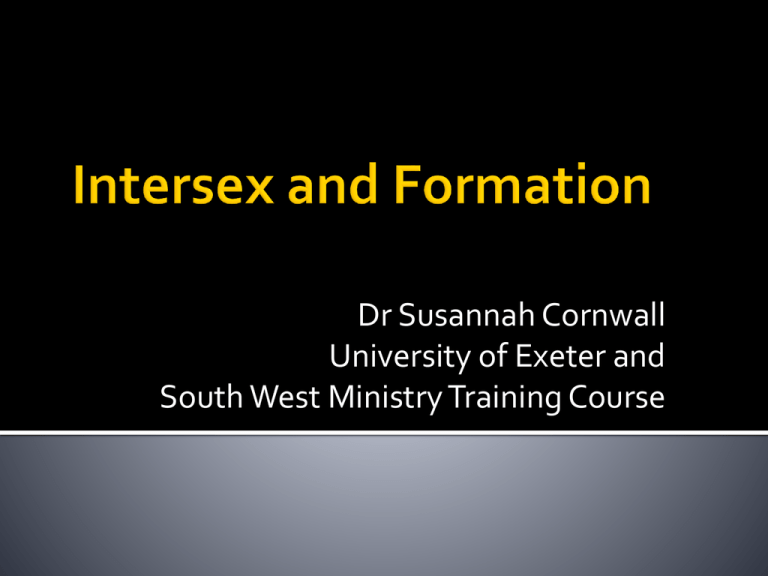
Dr Susannah Cornwall
University of Exeter and
South West Ministry Training Course
Physical difference from male or
female
Sometimes involves unusual
genitalia
Sometimes involves an unusual
combination of genitals, gonads,
chromosomes, other physical
characteristics
Some intersex people will have
undergone “corrective” surgery in
childhood and been assigned to a “best
gender of rearing”. This may not
“match” their gender identity later
Many intersex people feel like typical
men and women
Some intersex people identify as “third”
or genderqueer
Intersex people may be bisexual,
heterosexual, homosexual, etc…
Intersex people may or may not be
able to have penetrative sex
Intersex people may or may not be
able to have children
“‘Formation’ has the unfortunate
connotation of an external shape one
receives like a mould; the theology of
charismata corrects this by emphasizing
a growth from within, which will
produce the fruits that are necessary for
ministry, but not according to a uniform
pattern.” (Thompson 2004: 268-9)
“The language itself is indicative: ministry is
primarily about being, not doing; the minister is
formed for ministry, not trained or equipped;
she is remade, changed into something new:
there is an ontology of ministerial being …
Such a model is troublingly ideological. It
depends upon a hierarchical understanding of
being that seeks to reinforce clerical power
over the Church, and is governed by
relationships of submission, which are
potentially extremely harmful for those in
training.” (Green 2010: 114)
“The only possible preparation is the
emptying of the subject, the submission of its
agency in preparation for the new investiture,
signified by the public vesting of the clerical
collar and stole. As a model of ministerial
training this (de)formation must cast itself in
the language of deconstructing, of
brokenness and wounding, leaving the
ordinand throughout her training in a high
state of identity-anxiety and uncertainty.”
(Green 2010: 116)
“The sexual differentiation of men and
women is a gift of God … It is on male
and female that God gives his blessing,
which is to be seen not only in
procreation, but in human culture, too …
Persons are not asexual, but are either
male or female” (Archbishops’ Council
2013: 1, 9).
“Put more theologically, it is about helping
believers to see Christ in one another. The
interpretative work of the priest looks first at
how to uncover for one person or group the
hidden gift in another – especially when the
first impression is one of alienness and threat.
The priest is the instrument by which God’s
generosity is laid bare, and thus by which
generosity becomes possible for believers.”
(Williams 2004)
“On a good day I can really embrace my being
intersex and seeing the spiritual gifts that come
from that and I don’t believe it’s an accident that
I’ve been born this way. It’s been a very, very
difficult path but it’s been a very powerful path
as well. And in terms of the work I do now as a
counsellor it’s fantastic. It really is the kind of
wounded healer thing … I am very, very grateful
for the work that I do today. I know that I am
very good at the work that I do today. And that is
a gift.” (Sarah, quoted in Cornwall 2012: 3)
“God meant me to be like this; God’s backing
me and waiting to see what I do with what
I’ve been given. I’ve been given certain gifts.
I’ve had a lot taken away but, by Jove, I’ve
been given a lot as well.” (David, quoted in
Cornwall 2013: 227)
“Covenant commitments, vows and promises
can be risked precisely because the promise is
enabled and sustained from beyond self but
not in a way that excludes the self.
Notwithstanding my inconstancy, I can be
counted upon, because I am a promising self,
constituted by the God of promise.” (Pickard
2009: 220)
Chromosomes? XX
XY XXY XX/XY
mosaic
Genitalia? male female other
Gonads? testes ovaries ovotestes
one testis and one ovary
Hormone levels?
Gender identity?
Virginia Ramey Mollenkott argues, “God made no mistake by
creating intersexuals”. On what grounds might Christian
theologians agree or disagree with this statement?
What difference, if any, might it make to theologies of sex,
gender and sexuality if more Christians engaged with the
existence of intersex?
Should theologians take intersex people’s experiences into
account when constructing broader arguments about the
theological significance of sex, gender and sexuality?
How easy or difficult do you think it would be for intersex people
to understand and recognize themselves as made in God’s image
in your own worshipping/liturgical/studying/formational
context?
How well equipped is your denomination for intersex people’s
pastoral care and spiritual nurture?
Are there any particular aspects of your faith tradition or context
that you think would be challenged by intersex?
Archbishops’ Council (2013), Men and Women in Marriage: A Document from the Faith and Order Commission Published
with the Agreement of the House of Bishops of the Church of England and Approved for Study, London: Church House
Publishing
Beckwith, Roger, Sarah Finch, Charles Raven, Vinay Samuel and Chris Sugden (2011), The Church, Women Bishops and
Provision: The Integrity of Orthodox Objections to the Proposed Legislation Allowing Women Bishops, London: Latimer
Trust
Coakley, Sarah (1996), “Kenosis and Subversion”, in Hampson, Daphne (ed.), Swallowing a Fishbone? Feminist
Theologians Debate Christianity, London: SPCK, 82-111
Cornwall, Susannah (2012), “What Do Intersex Christians Say About Intersex and Faith?”, Manchester: Lincoln
Theological Institute, online at http://lincolntheologicalinstitute.com/iid-resources/
Cornwall, Susannah (2013), “British Intersex Christians’ Accounts of Intersex Identity, Christian Identity and Church
Experience”, Practical Theology 6.2, 220-236
Green, Brutus (2010), “Being Called Out: Vocation as a Model of Anglican Ministerial Training and Priesthood”,
Theology 113.872, 114-122
Hampson, Daphne (1990), Theology and Feminism, Oxford: Blackwell
Hampson, Daphne (1996), “On Autonomy and Heteronomy”, in Hampson, Daphne (ed.), Swallowing a Fishbone?
Feminist Theologians Debate Christianity, London: SPCK, 1-16
Liao, Lih-Mei (2007), “Towards a Clinical-Psychological Approach to Address the Heterosexual Concerns of Intersexed
Women”, in Clarke, Victoria and Elizabeth Peel (eds.), Out in Psychology: Lesbian, Gay, Bisexual, Trans and Queer
Perspectives, Chichester: John Wiley & Sons, 391-408
Mascall, E.L. (1978), “Some Basic Considerations”, in Moore, Peter (ed.), Man, Woman, and Priesthood, London:
SPCK, 9-26
Pickard, Stephen (2009), Theological Foundations for Collaborative Ministry, Farnham: Ashgate
Tanis, Justin (2003), Trans-gendered: Theology, Ministry, and Communities of Faith, Cleveland, OH: Pilgrim Press
Thompson, Ross (2004), “Academic Theology and Ministerial Formation: Towards a Contemplative Approach”,
Theology 104, 265-273
Van Huyssteen, Wessel (producer/director) (2003), The 3rd Sex, broadcast SABC (South Africa), November 2003
Walcutt, Heidi (1996), speaking in Hermaphrodites Speak! (video), Petaluma, CA: Intersex Society of North America
Williams, Rowan (2004), “The Christian Priest Today”, lecture on the occasion of the 150th anniversary of Ripon
College, Cuddesdon, Friday 28 May 2004, online at http://www.archbishopofcanterbury.org/1185

